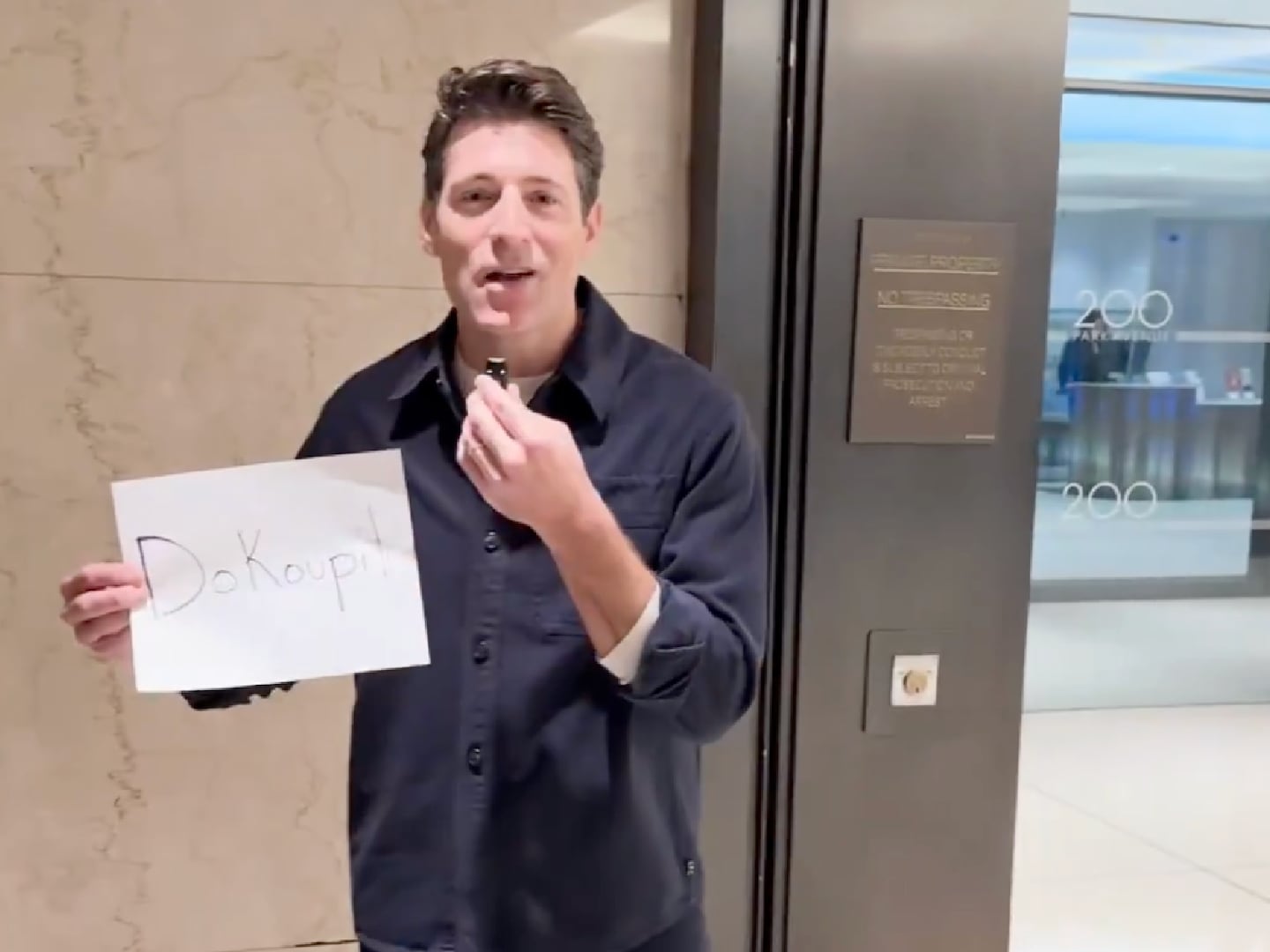Two and a half years ago, The Lehman Trilogy played in New York City’s cavernous Park Avenue Armory—and from where this critic was sitting it was lost, airless, and pretty unintelligible. Somewhere, over on my left, a stage consisting of a fancy glass cube fashioned into a variously partitioned office revolved in jerky fashion, as the story of the evolution of the famous banking family unfolded. Necks were craned, hopes the stage would draw closer were dashed. And this went on for over three and a half hours.
Now The Lehman Trilogy has opened on a conventional Broadway stage—praise be, no craned necks—and it feels a very different, much better show. The designer Es Devlin’s glass cube is now directly in front of us, and so are the actors. Now staged on a conventional scale, it’s an intimate, engrossing piece of theater, beautifully acted, designed, and lit. From being an epic oddity it’s become an epic meal, even as it sanitizes some history and bizarrely neglects to tell the rest.
Original company members Simon Russell Beale and Adam Godley return, with Adrian Lester joining the cast in his Broadway debut. First they play the three original Lehman brothers (Henry, Mayer, and Emanuel), and as the play progresses many other characters besides—whatever else the play is it’s a performative feast, and the three men are wonderful to watch. The characters exist as characters, and also provide third-person historical information, story notes, and stage directions. It is more sweeping commentary than play.
Through the three sections, “Three Brothers,” “Fathers & Sons,” and “The Immortal” we travel from the founding of the Lehman Brothers company by Henry in 1844 in Alabama to its destruction, buried by the sub-prime mortgage crisis and subsequent global financial meltdown of 2008. Beside the stage, the show’s musical director, Candida Caldicot, accompanies on a piano as a wry musical adjunct to unfolding history.
The playing of that piano, coupled with the language and stunning projections behind the cube by Luke Halls, take us from the cotton plantations of slavery-era Alabama to 21st century Manhattan, and underscore the dream-like quality of the play. Sometimes, New York Harbor and the Statue of Liberty face us. And when the Swinging Sixties hit, and all three actors are doing the Twist while standing on boxes, suddenly the projections fizz and blur to an intense, mesmerizing rapidity.
The historical sweep of the Lehman story takes in racism, the immigrant experience (the Lehmans were Jews from Bavaria), fraternal and familial tensions, capitalism, computers, and hubris. The delight of the play is less in the detail than in the telling. Stefano Massini’s script, adapted by Ben Power, is one of wit, debate, poetry and soliloquy; not mess, complication, and moral ambiguity. The script is most excited, like the brothers and their descendants, about a new opportunity to make money.

Adrian Lester in 'The Lehman Trilogy.'
Julieta CervantesThe three actors play not just the three brothers, but wives Pauline and Babette. Then they play their sons, Philip and Herbert, and Philip’s wife Carrie. They play Bobbie, Philip and Carrie’s son, and Ruth Lamar, Bobbie’s vamp-to-the-max first wife. It can be funny in the moment (particularly Godley’s virtuoso-played succession of potential wives that Philip considers), but the pantomime accenting and flutteriness of the female characters is grating. The play may have written women into the action, but it doesn’t know what to do with them, rather than just encourage us to laugh at their exaggeratedly drawn femininity.
As men, the actors have vastly more room for dramatic maneuver. Lester plays Emanuel as a forceful counterbalance to Henry in the company’s early years. Russell Beale nails Philip’s garrulous self-certainty (his supercilious pronouncements of “I take my leave” have stayed with me), Godley, in sunglasses, gives Bobbie a rock-star-styled strut.
The play evokes the Great Depression of 1929 (and the suicides of people on Wall Street at the time), rather than the 2008 crash, when no Lehmans were still alive to see the eradication of the family company. As time spins on, so does the glass cube.
The cube becomes a fourth character, a palimpsest whose sides end up scored with numbers from previous years—sums of money, war dead. The sign of the original firm, advertising itself as an outfitters is crossed out. “BANK” replaces it. The story is dense with detail, but not criticism. We learn a lot about the history of the company (and this is also available online and in books), but not much of the brothers’ and their descendants’ characters beyond the quirks and key moments in company history that give Lester, Russell Beale, and Godley the material for their acting tour de force.
When the world speeds up, so does the play—the projections become flashing, mega-figured financial abstractions, which reminded this critic of so many finance-related plays and movies (Enron, Margin Call) that used the same device.
The play is not critical of the Lehmans, but rather tells a very traditional story of capitalism—that family-run companies were morally superior to the shark-like, greedy technocrats that came in and took them over. We know that ultimate disaster is coming, by the way—the portents of doom in the play begin with plantation fires, and the recitation of lines like, “Everything is falling apart.” All three brothers have recurring apocalyptic dreams. A cold breeze is mentioned with foreboding, and the air conditioning in the theater indeed wafts over you (bring a jacket)—an unintentional but effective meeting of text and theater.
In service to giving the past a golden sheen, the play skates over whatever ruthlessness and greed underpinned the growth of a company like Lehman in the first place. What difference is there in the company changing its focus from clothes to cotton to railways in the name of making as much money as possible compared to the ruthless bankers of later years? Instead, the play humanizes and softens—placing the brothers’ Jewish identity and immigrant status as central, or noting how differently an old-style company grieves a figurehead compared to today’s soulless behemoth.
When Bobbie dies in 1969, the company first passes into the hands of Lewis ‘Lew’ Glucksman, then Pete Peterson, and finally Dick Fuld. The family was gone. After Bobbie’s death, the play doesn’t really sketch the last 39 years of Lehman Brothers. There is a rushed up-to-speed commentary, and a few pious intonations about the bogeyman of unfettered capitalism, and that’s it—with a startling final visual that feels more gestural than meaningful.
For a play that is so ruminative about the foundations of a giant of contemporary capitalism, it feels perverse to gloss so quickly over the circumstances of its final act. The Lehman Trilogy is a wonderful piece of theater, with three glorious performances. But it is more determined to memorialize what it insists was the fundamental decency of its ghosts, rather than sketch the seeding of characters and misdeeds that led to Lehman’s destruction.







